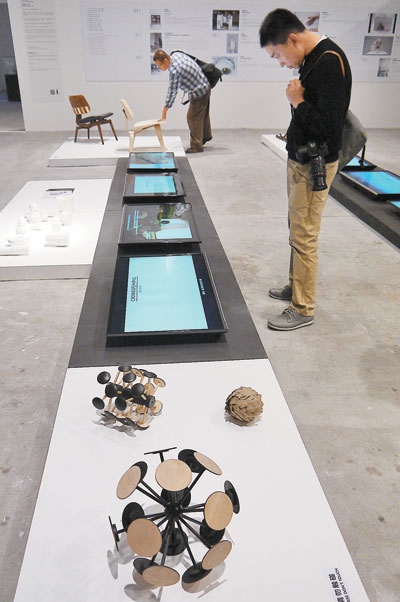|

Cao Zhen
caozhen0806@126.com
THE 2013 OCT-LOFT Creative Festival is being held at OCT-LOFT in Nanshan District, showcasing cutting-edge research projects from nine international institutes. Unlike other design exhibitions which display specific products, this festival eyes the future, focusing on design research and experimental projects.
Themed “Design Experimental Field,” the exhibition covers various design fields, such as new materials, new media and the creative use of urban space. The exhibiting institutes include Massachusetts Institute of Technology (MIT), University of the Arts London, Zurich University of the Arts and Geneva University of Art and Design.
“This exhibition is a field that leads to the future imagination,” said curator Li Degeng, deputy dean of the visual communication department of Tsinghua University’s Academy of Arts & Designs. “Design practice is usually restrained by short-term tasks and confined to solving problems, while design experiments and research are abstract with less certain goals. The OCT-LOFT festival shows a vision that is relatively hidden from the public yet exerts great impact on the creative industry and social life,” he added.
MIT’s “Mobile Voices” project is about a mobile blogging platform called Vojo. It is a groundbreaking effort that enables people to post content on the Web using cheaper mobile phones without Internet access. Vojo lets users create an account via short messaging service (SMS) and start posting right away via voice calls, SMS or multimedia messaging service.
Li said online social networking is popular among smartphone users, so the idea of “Mobile Voices” is to help poor people connect their communities to a social network that can increase the awareness to their social, cultural and political demands. MIT hosted workshops in the outskirts of Brazil and immigration communities in the United States to empower poor people to denounce the violence they witness in their communities. “This project is excellent in forming the relationship between technology and civic engagement. It amplifies poor people’s voices,” said Li.
The exhibition expresses the idea that the improvement and reconstruction of the world can be achieved through design experiment and research. The Netherland’s Sandberg Institute’s project, “Inside the White Whale,” presents an ideal strategy for occupying vacant buildings with minimal effort and materials. Researchers use large ship container bags to create temporary spaces in certain locations. “These new flexible spaces serve a wide variety of purposes, superimposing a new world over the existing one,” said Jurgen Bey, director of Sandberg Institute.
The project is based on a two-year master’s research called “Vacant NL” to encourage students to develop innovative and realistic design strategies for the temporary use of unused properties in the Netherlands. The pictures displayed at the exhibition show the bags were used by a hairdresser as working space or as social meeting place for a book club.
Germany’s Public Art Lab’s project, “Connecting Cities Network,” uses new media art and technology to research urban visual culture. The projects include a series of events taking place in 15 European cities. Susa Pop, director of the Berlin-based Public Art Lab, said: “Normally buildings in a city are regarded as owned by various organizations, which separate the city into pieces. We should look at the buildings as the inner part of the city and let the outer appearance of buildings function as a medium for people to communicate.”
The project uses large-format digital media in the public space and lets a broad public audience interact with the produced artwork shown on facades, screens or projection walls. By circulating artistic content, the project supports the idea of public space as a space for creativity and exchange of culture. In 2013, several “Connecting Cities Network” events already took place in Berlin, Liverpool, Linz, Madrid and Helsinki.
Although the exhibition focuses on research, there are still some actual design works. In Swiss Lucerne University of Applied Sciences and Arts’ project, “E-Broidery,” designers combine light and textile to create a changing appearance of the textile surface. They develop innovative textiles with integrated electronic components, such as LED, sensors and solar panels. The university spent three years collaborating with Swiss embroidery company Forster Rohner AG and has introduced the creation into an industrialized process. At the exhibition, the university showcases the first light textiles, “Elumino Curtain.” Other applications of light textiles are lamps, nightgowns and security apparels.
“Light as a component is dynamic and immaterial compared to static and material elements, such as color and form. ‘E-Broidery’ textiles create a unique atmosphere in a room. This change may bring more potential for furniture and clothes,” said Isabel Rosa Muggler, co-director of Lucerne University’s products and textiles department.
Dates: Until March 8
Hours: 10 a.m.-6 p.m. Closed Mondays
Venue: B10, North Area, OCT-LOFT, Nanshan District (南山区华侨城创意文化园北区B10)
Metro: Luobao Line, Qiaocheng East Station (侨城东站), Exit A
|

